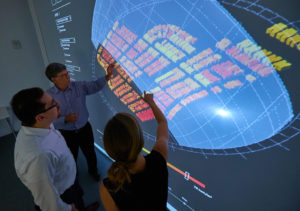Integrating energy datasets and visualization methods to identify, design, and test opportunities for energy conservation, production, and architectural and urban planning strategies for clean and renewable energy
 VIS-SIM: A Community Energy Dashboard
VIS-SIM: A Community Energy Dashboard
A new generation of urban building energy models (UBEMs) are currently being developed to estimate neighborhood-scale hourly energy demand loads. The goal for such tools is to explore “what if” scenarios for various design strategies, and to prioritize the most effective solutions. The objectives of this research are to visualize the relationships between three critical and closely related subjects that are not yet integrated within existing UBEMs: 1) the functioning of the electric grid and how it can be made cleaner, more efficient and more resilient; 2) the use of energy by buildings and how this can be minimized while also improving building functionality and the comfort of occupants; 3) the dynamic external available natural resources of solar and wind energy for matching resource with demand. Using currently acquired energy-use datasets from the Pecan Street Institute for residential buildings in Austin, TX, combined with our current visualization techniques and urban building simulation tools, a new UBEM is developed to simulate, test, and visualize future scenarios and strategies. Given the significantly large share of carbon emissions accounted for by electricity generation and energy use by buildings, and the comparison between supply, demand, and available renewable resources, the understanding and tools that result from this visualization project, and succeeding projects enabled by this one, will be of critical economic and social value. Expected outcomes of this proposed work will lead to a methodology that can be applied to similar studies in Northeast communities, such as Syracuse, New York. Through these multiple climate region testbeds, the integration of energy datasets and visualization methods enable the design, testing, and identification of opportunities for energy conservation, production, and architectural and urban planning design strategies and guidelines for clean and renewable energy.
Research Team:
- Bess Krietemeyer
- Tarek Rakha
- Jason Dedrick
Research Assistants:
- Ehsan Sabaghian
- Camila Andino
- Sou Fang
- Sarah Ritchey
- Beilei Ren
Sponsors:



